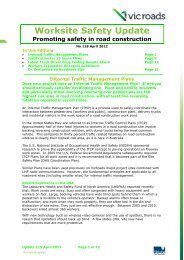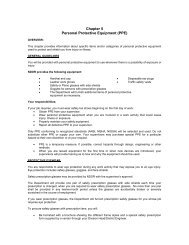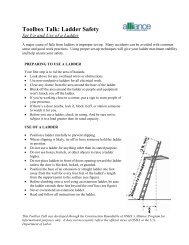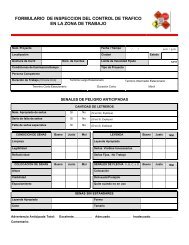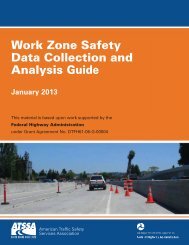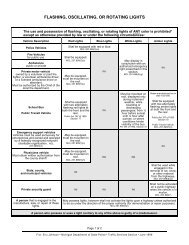California Joint Utility Traffic Control Manual - National Work Zone ...
California Joint Utility Traffic Control Manual - National Work Zone ...
California Joint Utility Traffic Control Manual - National Work Zone ...
Create successful ePaper yourself
Turn your PDF publications into a flip-book with our unique Google optimized e-Paper software.
<strong>California</strong> <strong>Joint</strong> <strong>Utility</strong> <strong>Traffic</strong> <strong>Control</strong> <strong>Manual</strong><br />
2. Make sure that equipment is secured and that the work area is left orderly. Cover or<br />
barricade exposed openings (trenches, excavations, bell holes, etc.) to assure<br />
protection of the public.<br />
Night Operations<br />
Night Operations should be set up pursuant to the <strong>National</strong> Cooperative Highway<br />
Research Program (NCHPP) report 476, guidelines for design and operation of nighttime<br />
traffic control for highway maintenance and construction.<br />
In order to provide enhanced warning and safety during twilight and night operations, the<br />
following steps are recommended:<br />
1. When the work area is to be illuminated by use of flood lights, the light placement<br />
shall be such that the light beams are not hazardous to oncoming traffic.<br />
2. All warning signs and channelizers shall have reflective properties.<br />
3. Flashing or rotating amber lights on vehicles may be used when the vehicles are<br />
blocking established traffic lanes or for additional work area protection.<br />
NOTE: Flares and red emergency lights and reflectors are strictly for emergency<br />
situations and must not be used as substitutes for standard work area warning<br />
devices. Flares shall not be used in high hazard fire areas.<br />
TTC Sign Recommendations<br />
All temporary traffic control signs shall be sized to be in accordance with CA MUTCD<br />
Table 6F-1, Sizes of Temporary <strong>Control</strong> Signs.<br />
Approved warning signs shall be installed and properly maintained whenever hazards<br />
exist due to moving or stationary vehicles, open excavations, construction or<br />
maintenance operations or similar work. Warning signs shall be placed so as to provide<br />
adequate notice to motorists, bicyclists or pedestrians that they are approaching an<br />
excavation, obstruction or hazard. Warning signs shall be removed as soon as the<br />
excavation, obstruction or hazard is removed or cleared.<br />
<strong>California</strong> MUTCD Section 6F.105(CA):<br />
OPEN TRENCH Sign (C27(CA))<br />
The OPEN TRENCH sign shall be used in advance of open trenches in/or<br />
adjacent to roadway. The edge of the traveled way shall be defined by edge line<br />
delineation consisting of appropriate markers or striping. Edge line delineation<br />
shall be white when located on the right of traffic and yellow when located on the<br />
left of traffic.<br />
Standard:<br />
Trenches in excess of 0.25 ft (3-inches) in depth that are less than 8 ft from the<br />
edge of traveled way shall be identified by C27(CA) and NO SHOULDER<br />
(C31A(CA)) portable signs on Type II or Type III barricades alternately set in the<br />
trench at intervals not to exceed 2,000 ft.<br />
14



